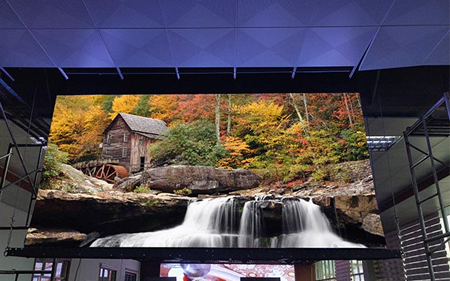As we all know, point-by-point calibration is a technology used to improve the color uniformity and color fidelity of flexible LED screen displays. From the analysis of market demand now, the necessity of on-site calibration is becoming more and more prominent. That is, data on the brightness and chromaticity of each pixel (or each primary color sub-pixel) area on the flexible LED screen is collected and the correction coefficients of each primary color sub-pixel or the correction coefficient matrix of each pixel are given. Uniformity calibration is classified as: factory calibration, repair calibration, service area calibration, and on-site calibration, allowing the picture of the flexible LED screen to be pure and delicate, and the colors are truly restored.

The mainstream technology for point-by-point calibration of flexible LED screens is mainly to use LED box point-by-point calibration.
Box calibration is the last step arranged before leaving the factory, mainly used to eliminate the brightness and chromaticity differences between the inside and between the boxes, and improve the uniformity of the splicing after the flexible LED screen. In the production process, in addition to adding the calibration process, the manufacturer generally needs to follow up on the calibration effect of the screen leaving the factory.
The first is to splice all the boxes of the flexible LED screentogether to observe the display effect, but the splicing workload is relatively large and inconvenient to implement.
The second is to randomly select some box of the flexible led display screen to splice and observe the correction effect.
The third is to use the measurement data recorded by the calibration system to simulate and evaluate the calibration effect of all boxes, adding LED box calibration and simulation evaluation/inspection links to the LED production line.
Before the point-by-point correction of the flexible LED screen, the following preparations need to be made:
Clean the flexible LED screen:
Remove dust and stains from the light surface and mask of the flexible LED screen to avoid affecting its brightness. If a new mask is required, make sure the color of the mask is consistent with the previous one, otherwise the display will be affected, especially during the day, and the improvement after correction will be limited.
Replace modules with malfunctioning functions:
This includes modules with some lights that do not light up, modules with a large number of dead lights, modules with abnormal scanning, modules with overall dim lights (resistance may be incorrect), and modules with display problems caused by problems with wires or interfaces, etc. Ensure that the display, scanning, and image are normal, without dark or always-on lights, and other phenomena.
Upgrade the receiving card:
If the current receiving card used by the flexible LED screen does not support correction or the number of load points is insufficient, it needs to be upgraded. Because there is a risk of dead cards during receiving card upgrades, customers need to contact the control system company in advance for upgrades and related processing.
Reminder: The led screen brightness correction only improves the uniformity of full-screen display or improves real problems caused by inconsistent brightness by lowering the brightness of some lights, and cannot improve the brightness of lights, change the angle of light emission, or correct display problems caused by hardware functional issues (power supply, resistance, wiring).
The collection of calibration data needs to be carried out in an environment without wind, rain, or fog interference:
After the point-by-point correction is completed, the subsequent maintenance of the flexible LED screen faces new problems, such as data updates after replacing receiving cards or modules, and adjusting the target brightness and color gamut of the display screen. These are all tasks that must be done well after the point-by-point correction.